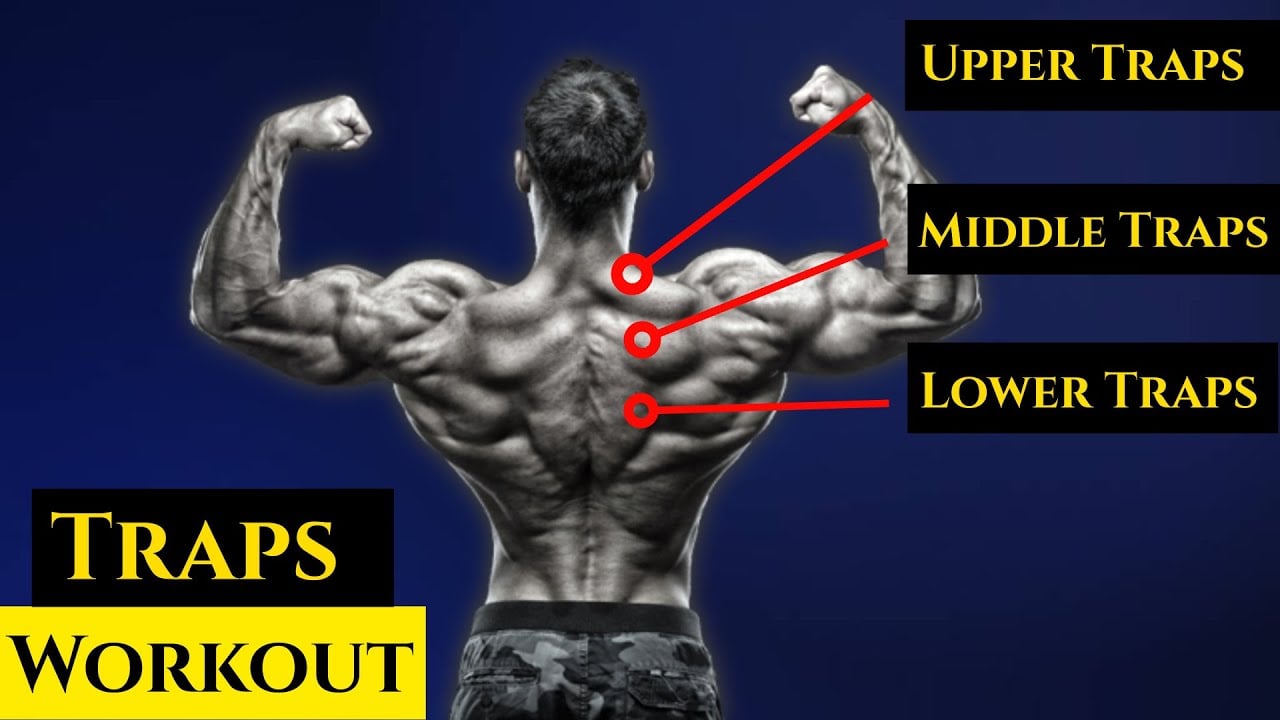I’ve tested different trap exercises for years, and I can tell you that dumbbells are the best tool for building huge traps.
Why? Because dumbbells allow for a greater range of motion and hit your traps from angles that barbells can’t reach.
In this guide, I’m sharing the 10 BEST dumbbell exercises for your trapezius muscles—the upper, middle, and lower trap.
These aren’t random exercises I found on Google.
These are proven movements that deliver actual results when performed correctly.
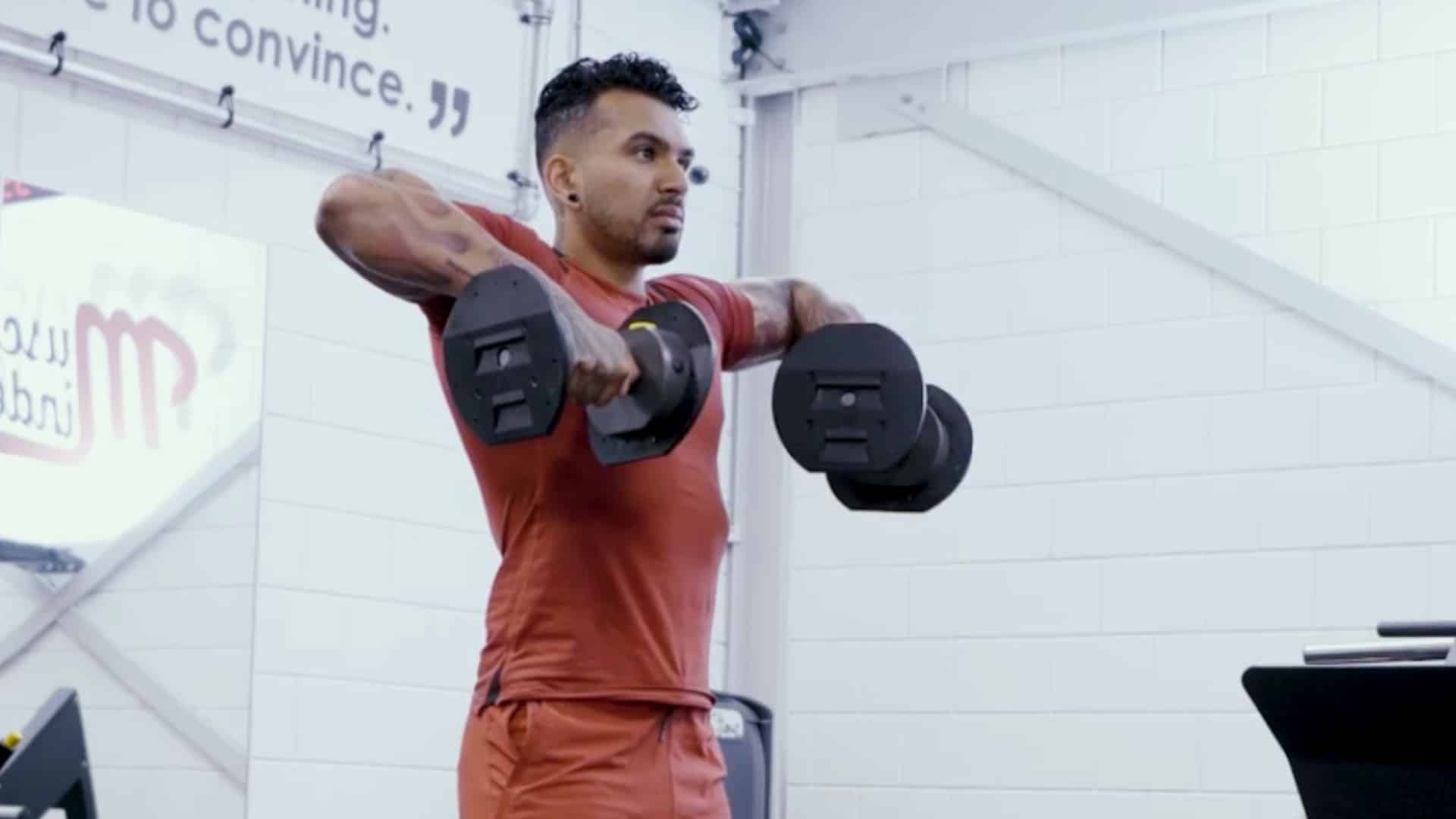
- 10 Best Dumbbell Trap Exercises For Home or Gym
- 1. Dumbbell Shrug
- 2. Incline Y-Raise
- 3. Incline Dumbbell Shrug
- 4. Dumbbell Farmers Walk
- 5. Bent Over Dumbbell Lateral Raise
- 6. Lying Dumbbell Rear Delt Row
- 7. Incline Dumbbell T Raise
- 8. Dumbbell Upright Row
- 9. Renegade Row
- 10. Seated Bent-Over Rear Delt Row
- Trapezius Muscle Anatomy
- FAQs
- How to get bigger traps with dumbbells
- Are Dumbbell Shrugs Enough for Building Big Traps?
- How to Target Your Lower Traps with Dumbbells
- References
- Best Trap Exercises For Muscle Mass & Strength
10 Best Dumbbell Trap Exercises For Home or Gym
Some of the best dumbbell trap exercises to add to your workout routine include:
1. Dumbbell Shrug
Dumbbell shrug is one of the most straightforward yet incredibly effective exercises for building upper trap size and strength.
Its primary function during this movement is scapular elevation — in simpler terms, lifting your shoulders straight up.
Electromyography results indicated that the shoulder shrug exercise significantly increased upper trapezius activation compared to the other dumbbell exercises.
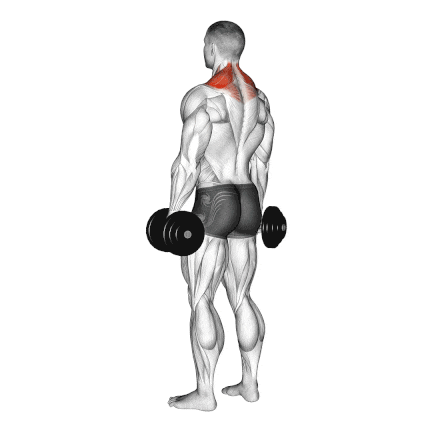
How To Do
- Stand tall with your feet shoulder-width apart. Hold a dumbbell in each hand with a neutral grip (palms facing your body). Let your arms hang naturally at your sides.
- Maintain a slight bend in your knees if that feels more stable, but your torso should be upright.
- Your shoulders should be down and back slightly, not rounded forward. Keep your head in a neutral position, looking straight ahead. Brace your core lightly.
- Without bending your elbows significantly or using momentum from your legs or back, you should shrug your shoulders straight UP towards your ears.
- Imagine you’re trying to touch your ears with the top of your shoulders.
- Hold the contraction at the very top of the movement for a brief pause for 1-2 seconds. Squeeze your traps together.
- Slowly and carefully lower the dumbbells back up to the starting position. Do not just let the weight drop.
- Repeat the movement for the desired number of repetitions, typically 8-15 reps for 2-3 sets.
Tips
- Shrugs are an up-and-down motion, not a circular one. Rolling stresses the shoulder joint unnecessarily and doesn’t effectively increase trap activation.
- Try not to move anything but your shoulders.
- Inhale when you lower the weight and exhale when you lift.
- Limit momentum and excessive jerking or bouncing of the weight.
- Master the form first with moderate weights before lifting the heaviest dumbbells in the gym. You’ll get better results from 12 quality reps than 4 sloppy ones.
2. Incline Y-Raise
Y Raises are a great and easy-to-do shoulder stability exercise that targets both the rotator cuff muscles and your mid and lower traps.
Although the Y Raise is commonly performed on an incline bench, it can be modified to suit your needs and performed in various ways: standing on the floor, on a flat or incline bench, or even on a Swiss ball.
You should add this dumbbell trap workout to your workout regimen.
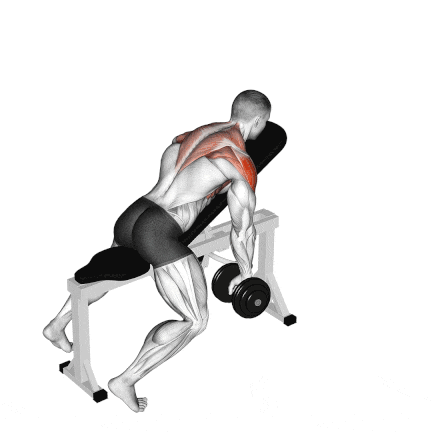
How To Do
- Set an adjustable bench to a low incline. Start around 30 degrees, but you can experiment with angles from 15 to 45 degrees to find where you best feel the target muscles.
- Grab a pair of very light dumbbells. Lie face down on the bench, chest resting on the pad.
- Let your arms hang straight down towards the floor, positioned just outside the width of the bench.
- With arms kept mostly straight (a very slight bend is okay), simultaneously raise both dumbbells out to the sides and slightly forward, forming a “Y” shape relative to your body.
- Raise the dumbbells until your arms are roughly parallel to the floor, or slightly higher.
- Slowly and under control, lower the dumbbells back to the starting position. Allow your shoulder blades to move naturally apart as the weight descends.
Tips
- Start with lightweight. Do not attempt an ego lift; it’s about activating specific muscles. The weight is likely too heavy if you can’t do 15+ controlled reps.
- Don’t shrug upwards with your upper trap. Think about pulling your shoulder blades down your back and bringing them together. Feel the contraction between and below your shoulder blades and in the back of your shoulders.
3. Incline Dumbbell Shrug
The Incline Dumbbell Shrug is a variation of trap dumbbell shrug exercises that strengthen the upper part of the trapezius and neck region and also help to improve posture.
This movement focuses on scapular elevation and retraction, engaging both the upper and mid-trapezius fibres due to your body’s forward angle.
Because your chest is pressed against the bench, it will be hard to use momentum to lift the weight up.
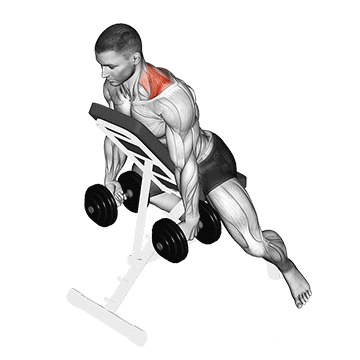
How To Do
- Grab a weight bench and set the incline to roughly 30-45 degrees. Lie face down on the bench, letting your chest rest against the pad. Your feet can be planted on the floor for stability.
- Experiment with the angle! Some people feel it is better slightly flatter (around 30), others steeper (closer to 45). Find what allows you to feel the target muscles working best.
- Hold a dumbbell in each hand with a neutral grip (palms facing each other). Let your arms hang straight down towards the floor.
- Slowly shrug your shoulders up toward your ears.
- At the top, pause momentarily and contract hard through your traps and rhomboids.
- Slowly lower the weights back to the starting position.
Tips
- This exercise often responds well to higher rep ranges, such as 10-20 reps.
- I typically program incline shrugs after heavy compound pulling (like rows). It can also be paired with rear delt exercises.
- Move the dumbbells smoothly and evenly without jerking them at all.
- Keep your arms mostly straight (a very slight bend is fine, but don’t curl the weight), pull your shoulder blades down and slightly BACK
4. Dumbbell Farmers Walk
This isn’t your typical “lift the weight up and down” exercise. It’s a loaded carry, a functional movement pattern we do in everyday life (carrying groceries, moving furniture), but scaled up with serious weight.
While it’s famous for building killer grip strength, the Farmers Walk is an absolute beast for developing isometric strength and endurance in your traps, core, and shoulders.
This is one of my favourite exercises because it integrates multiple muscle groups and builds real-world strength. While walking with a heavy weight, the traps work to keep everything stable.
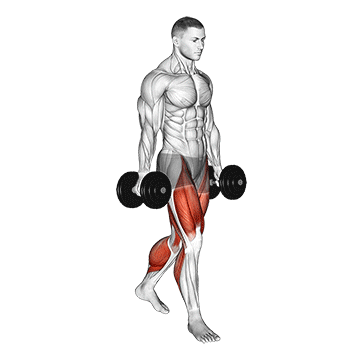
How To Do
- Choose two heavy dumbbells of equal weight. Position them on the floor just outside your feet.
- Hinge at your hips with a slight bend in your knees (like the start of a deadlift). Grip the dumbbells firmly in the center of the handles.
- Once standing, let the dumbbells hang naturally at your sides. Your arms should be relatively straight, palms facing your body (neutral grip).
- Stand tall, pull your shoulders slightly back and down, chest proud, and look straight ahead.
- Begin walking with short, controlled steps. Avoid excessive swinging of the weights. Maintain your upright posture throughout the entire walk.
- Walk for a predetermined distance or time. To finish, safely lower the dumbbells back to the floor by hinging at your hips with a straight back, just like you picked them up.
Tips
- Keep a neutral or straight spine throughout the movement to avoid injury.
- If your posture breaks down, the set is over. You get the most trap activation when you actively resist the weight trying to pull you out of alignment.
- Keep a steady pace. Avoid rushing or “stomping.” Each step should be controlled, with hips level and eyes forward.
5. Bent Over Dumbbell Lateral Raise
Bent-over raises are an excellent exercise for isolating and working specifically on the rear deltoid, middle, and lower trap muscles. They are a must for complete shoulder muscle development.
Thus, the exercise hit precisely the rear delt and mid-trap head by isolating it.
This exercise can be performed in both a standing and a seated position. I prefer the seated version, as it requires strict movement.
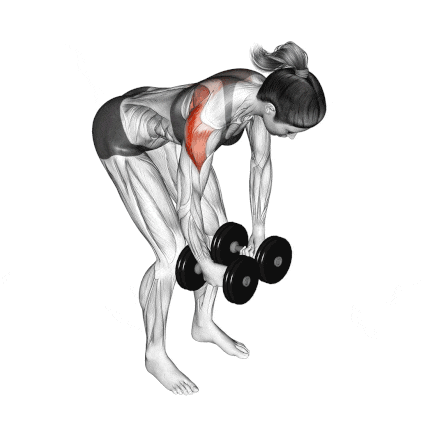
How To Do
- Stand with your feet shoulder-width apart. Hold a dumbbell in each hand with a neutral grip (palms facing each other). Hinge forward at your hips, keeping your back straight and chest up, and keep your back straight and chest up. Y
- Our torso should be roughly parallel to the floor, or slightly higher. Let the dumbbells hang straight down in front of you, below your shoulders.
- Keep your elbows bent and lift the dumbbells out to the sides in a wide arc.
- Raise the dumbbells until your upper arms are roughly parallel to the floor.
- Slowly and with control, lower the dumbbells back to the starting position.
Tips
- One of the biggest mistakes people make is swinging their arms or leading with their hands. Instead, keep a soft bend in the elbows and imagine lifting with your elbows to engage the rear delts and mid-traps.
- If you struggle with maintaining form or back position in the standing version, the bench-supported variation is gold standard for strict execution
6. Lying Dumbbell Rear Delt Row
Dumbbell Lying Rear Delt Row is a strength exercise that works your side deltoids and trap.
It is an excellent basic move. When done correctly, it can effectively target your shoulders and upper body.
The muscles used for dumbbell lying rear delt row may change slightly based on your trained range of motion and technique.
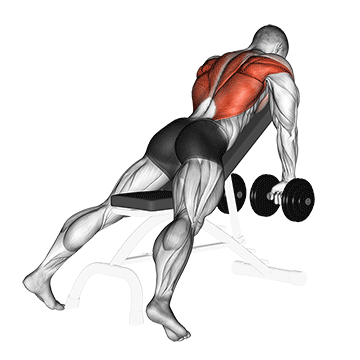
How To Do
- Start off lying on an incline bench with a dumbbell in each hand extended out in front of you.
- Slowly pull the dumbbells until your elbows are just above your shoulders.
- Once you reach the final position, hold for a count and squeeze your muscles.
- Return to the starting position and repeat for as many reps and sets as desired.
Tips
- Keep a controlled motion and avoid jerky movements.
- Pause momentarily at the top before slowly lowering the dumbbell back to the starting position.
7. Incline Dumbbell T Raise
The Incline Dumbbell T Raise is an underrated gem for targeting the middle trapezius and posterior deltoids.
It is commonly used in rehabilitation to enhance range of motion and increase strength in the entire shoulder complex.
I use this exercise to address imbalances often seen from too much pushing and insufficient pulling and retraction work. It’s fantastic for building scapular awareness and control.
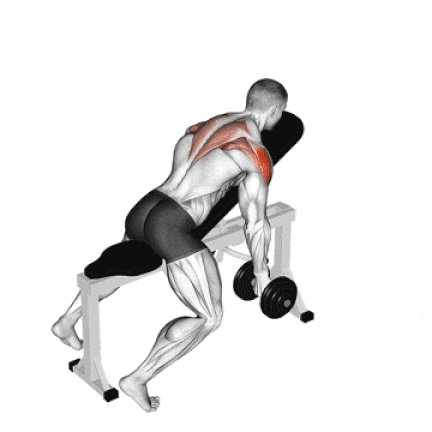
How To Do
- Adjust an incline bench to a 45-degree angle and lie face down with your chest against the bench.
- Grab dumbbells with an underhand grip, letting them hang directly under your shoulders.
- Keep your arms straight and slowly raise the dumbbells up and out to the side until they reach shoulder height.
- Pause for a second and then slowly lower the dumbbells back down to the starting position.
- Repeat for the desired number of reps.
Tips
- Keep your chest firmly against the bench throughout the exercise.
- Engage your shoulder blades by squeezing them together as you lift the dumbbells.
- Focus on lifting with your shoulders and keeping your arms straight, rather than using momentum to swing the weights up.
- Breathe in as you lower the dumbbells, and exhale as you lift them up.
8. Dumbbell Upright Row
The dumbbell upright row is a compound exercise that builds stronger and bigger traps and deltoids (Shoulders).
It is one of the best middle and upper trap exercises for building huge trapezius muscles.
The combination of Upright Rows and shrugs can create massive traps. It can be done with both narrow grips and wider ones.
- The normal grip upright row provides overall shoulder development and suits those seeking balanced muscle activation.
- The narrow grip upright rows emphasize more on the upper trap and a little less on the lateral and rear delt.
- The wide-grip upright row places heavy emphasis on the lateral and rear deltoid and little less on the upper and middle trap.
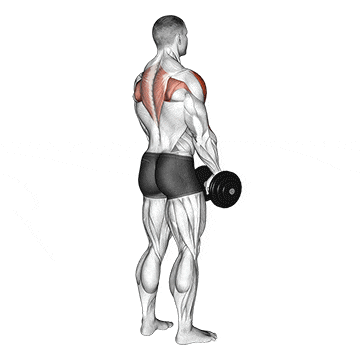
How To Do
- Stand with your feet shoulder-width apart, maintaining a straight posture.
- Hold a dumbbell in each hand with an overhand grip (palms facing your body).
- Lift the dumbbells by pulling them straight up towards your chest.
- Aim to bring the dumbbells up to the level of your collarbone, just below your chin.
- Squeeze your shoulder blades together at the top of the movement.
- Inhale as you slowly lower the dumbbells back down to the starting position.
- Now, lower the dumbbell under controlled motion until it returns to its starting position.
- Repeat for 8 to 12 reps.
Tips
- Keep the weight close to the body.
- Keep a controlled motion and avoid jerky movements.
- Keep your back straight.
- Avoid shrugging your shoulders upward; the movement should be focused on pulling the elbows up and back.
9. Renegade Row
The renegade row is a full-body exercise that targets the primary muscle groups of the back, shoulders, and core while also engaging the triceps, biceps, and legs.
It’s a powerful combination traditional plank and dumbbell row:
- The Strength Component: You’re rowing, hitting those key upper back muscles.
- The Stability Component: You’re holding a plank, demanding serious core, shoulder, and hip control to resist rotation.
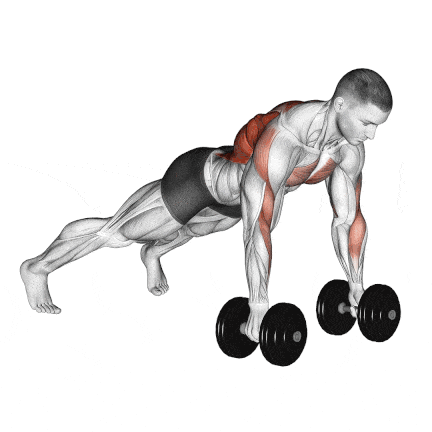
How To Do
- Place your two dumbbells on the floor, about shoulder-width apart.
- Get into a high plank position, gripping the dumbbell handles firmly. Your hands should be directly underneath your shoulders, your wrists straight, and your knuckles facing forward.
- Your body should form a straight line from the crown of your head down through your heels. Avoid letting your hips sag towards the floor or pike up towards the ceiling.
- Start with your feet slightly wider than hip-width apart. This gives you a wider support base and makes resisting rotation easier, especially when you’re learning. As you get stronger, you can bring your feet closer together.
- Brace your core as if you’re anticipating a punch to the stomach. Squeeze your glutes hard. This locks your torso in place.
- Maintaining that rigid body position and engaged core, exhale and pull one dumbbell straight up towards your rib cage.
- Briefly pause at the top, squeezing your back muscles. You should feel the work primarily in your upper back (lats, rhomboid).
- Inhale and slowly lower the dumbbell back to the floor with control. Don’t let it drop.
- Once the dumbbell is back on the floor and stable, re-engage your core and glutes if needed. Ensure your plank is still solid.
- Repeat steps 6-9 with the other arm.
- One row on each side typically counts as one complete repetition of the Renegade Row.
10. Seated Bent-Over Rear Delt Row
The seated rear delt row is an effective rowing exercise variation that targets the upper back and shoulders muscles.
Sitting on a bench eliminates any leg assistance and allows for a more isolated movement.
This exercise involves horizontal shoulder abduction and pulling the elbows behind the body. It primarily targets the rear delt and engages the upper back muscles, including the rhomboids and the middle and lower trapezius muscles.

How To Do
- Sit on the edge of a bench or a chair with your feet flat, shoulder-width apart.
- Hold a pair of dumbbells with an overhand grip, and let your arms hang straight down in front of you.
- Bend forward at your hips, keeping your back flat and your core engaged.
- With your elbows slightly bent, lift the dumbbells to the sides until your upper arms parallel the ground.
- Squeeze your shoulder blades together at the top of the movement.
- Lower the dumbbells back down to the starting position.
- Repeat 8-12 repetitions.
Trapezius Muscle Anatomy
The trapezius muscles, or trap muscles, are a large muscle group in the upper back. Providers call it the trapezius because of its shape. It looks like a trapezoid (a shape with four sides, two that are parallel).
Healthcare providers divide the trapezius into three areas. Each area helps you with a specific kind of movement.
The three parts of the trapezius help you move your head, stand up straight, bend or twist your torso and raise your arms.
As mentioned above, the trapezius muscle is divided into 3 areas:

FAQs
How to get bigger traps with dumbbells
There are many great trap exercises that you can do with dumbbells to help you build bigger traps.
You should add the dumbbell exercises mentioned above to your upper body training sessions to build bigger, stronger traps.
Shrugs and upright rows can be used to build up the upper traps, and pulling the shoulder blades together can build up the middle and lower traps.
The quickest way to build big trap muscles is with an intensive workout routine, which typically consists of 2–3 exercises, including the farmer’s carry and dumbbell shrugs.
Perform the workout twice a week and take at least 3 days of rest between each workout.
Are Dumbbell Shrugs Enough for Building Big Traps?
Dumbbell shrugs are a good exercise for building traps, but they may not be enough.
It is important to incorporate several exercises that target different areas of the traps, such as barbell shrugs, upright rows, and face pulls.
How to Target Your Lower Traps with Dumbbells
To target your lower traps with dumbbells, try exercises like Incline Y Raise, Dumbbell Rear Delt rows, and Reverse flys.
Focus on proper form and engage your lower traps by pulling your shoulder blades down and back.
References
- Andersen, L. L., Andersen, C. H., Skotte, J. H., Suetta, C., Søgaard, K., Saltin, B., & Sjøgaard, G. (2014). High-intensity strength training improves function of chronically painful muscles: Case-control and RCT studies. Biomedical Research International, 2014, 187324. https://doi.org/10.1155/2014/187324.
- Ekstrom RA Donatelli RA Soderberg GL. Surface electromyographic analysis of exercises for the trapezius and serratus anterior muscles. J Orthop Sports Phys Ther. 2003; 33:247-258
- Schory A, Bidinger E, Wolf J, Murray L. A systematic review of the exercises that produce optimal muscle ratios of the scapular stabilizers in normal shoulders. Int J Sports Phys Ther. 2016 Jun;11(3):321-336.
Best Trap Exercises For Muscle Mass & Strength

Manish is a NASM-certified fitness and nutrition coach with over 10 years of experience in weight lifting and fat loss fitness coaching. He specializes in gym-based training and has a lot of knowledge about exercise, lifting technique, biomechanics, and more.
Through “Fit Life Regime,” he generously shares the insights he’s gained over a decade in the field. His goal is to equip others with the knowledge to start their own fitness journey.

